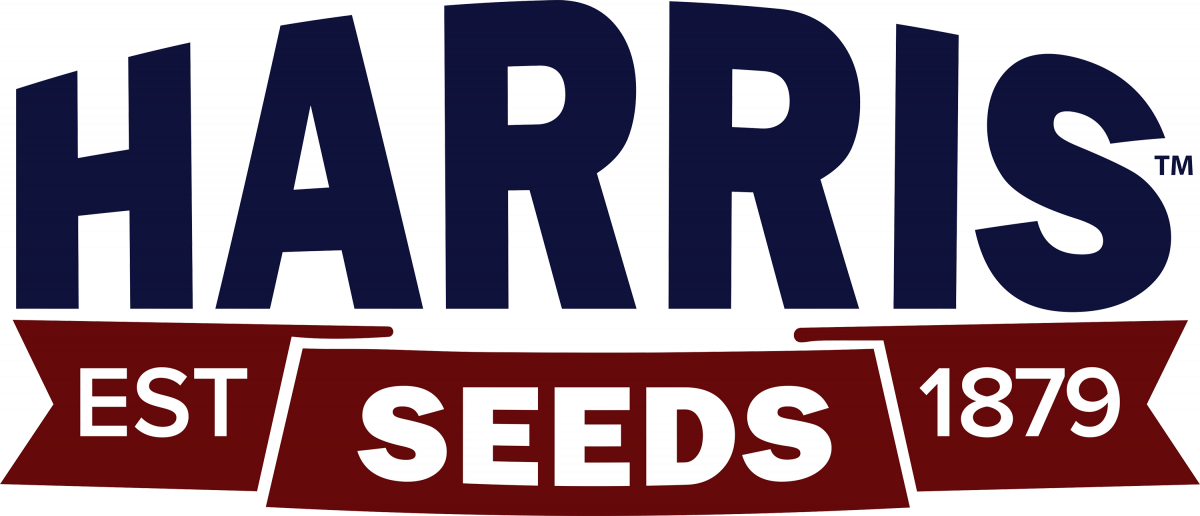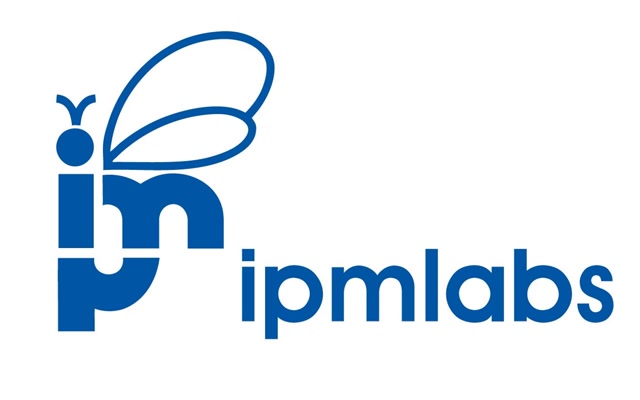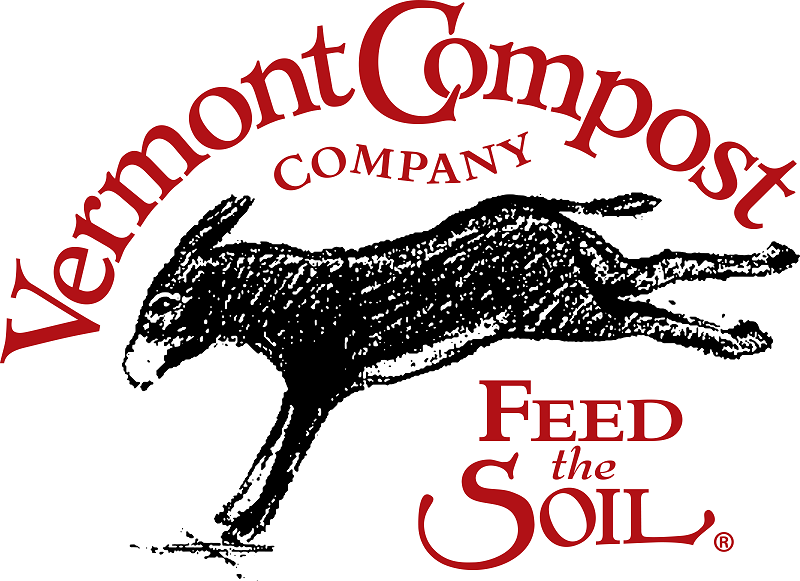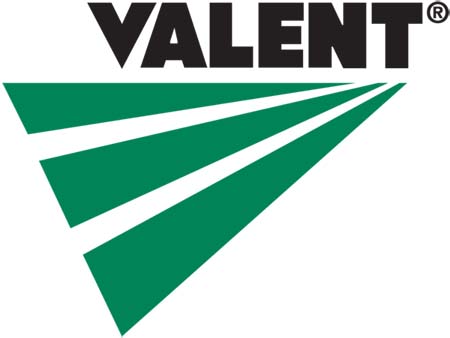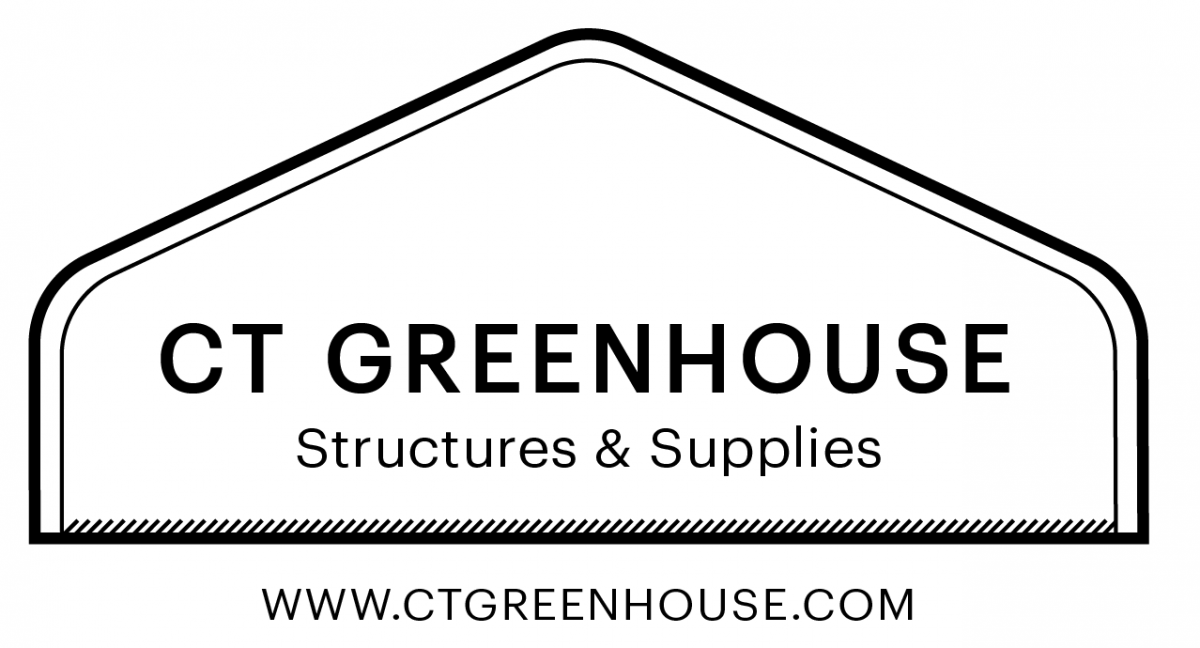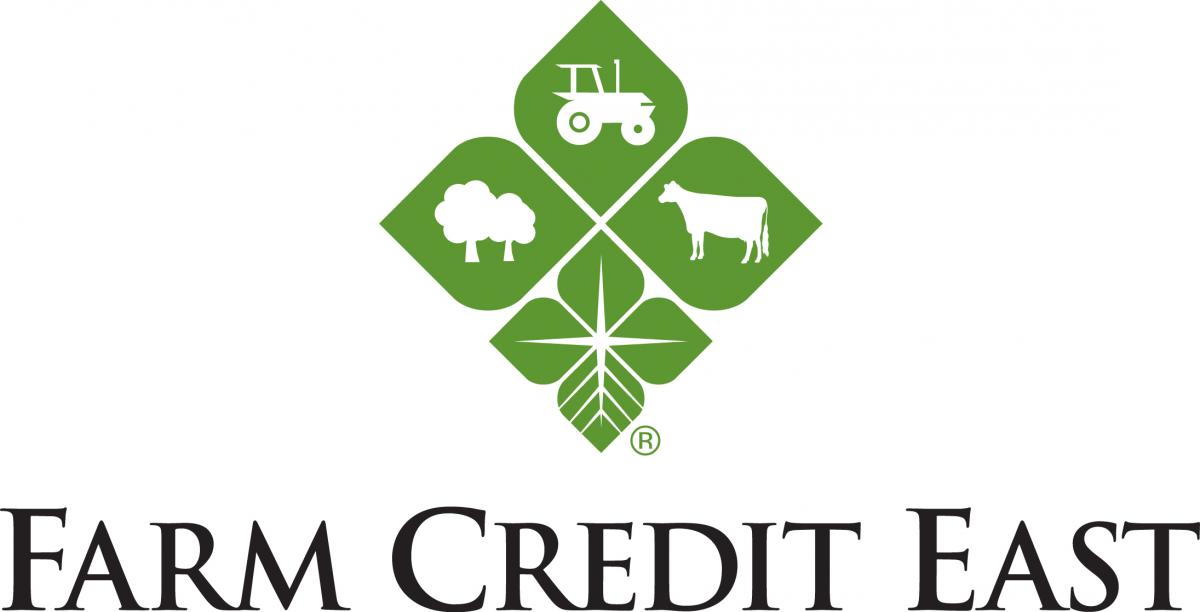Managing Fungus Gnats and Shore Flies
Calculating Fertilizer Applications
Improve Pest Management By Planning Ahead
News
Events
To print this issue, either press CTRL/CMD + P or right click on the page and choose Print from the pop-up menu.

Crop Conditions
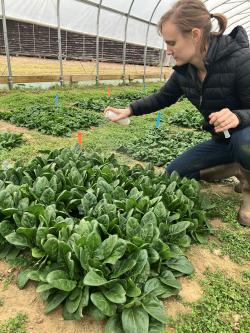 It felt like spring for a few days there, and now the cold is back, but greenhouses are filling up with trays of seedlings nonetheless and folks are busy turning over high tunnels in preparation of planting summer tomatoes, peppers, and cucumbers. The earliest tomatoes are already in the ground in heated tunnels and greenhouses. After the extreme rainfall last year, and the drought the year before, there’s reasonable anxiety about climate change and what might be coming for this season. As the climate continues to change, the Northeast is expected to continue to have periods of drought punctuated by erratic heavy downpours, with daily average and maximum temperatures increasing during the day and nighttime. It is harder to predict the weather since the patterns are changing, but we find these seasonal outlook maps from NOAA to be a useful look ahead. The seasonal outlook for May, June, and July show most of MA is likely to experience above average temperatures and about normal precipitation, Let’s hope they are right, and try to rest a bit easier and plan ahead with this information.
It felt like spring for a few days there, and now the cold is back, but greenhouses are filling up with trays of seedlings nonetheless and folks are busy turning over high tunnels in preparation of planting summer tomatoes, peppers, and cucumbers. The earliest tomatoes are already in the ground in heated tunnels and greenhouses. After the extreme rainfall last year, and the drought the year before, there’s reasonable anxiety about climate change and what might be coming for this season. As the climate continues to change, the Northeast is expected to continue to have periods of drought punctuated by erratic heavy downpours, with daily average and maximum temperatures increasing during the day and nighttime. It is harder to predict the weather since the patterns are changing, but we find these seasonal outlook maps from NOAA to be a useful look ahead. The seasonal outlook for May, June, and July show most of MA is likely to experience above average temperatures and about normal precipitation, Let’s hope they are right, and try to rest a bit easier and plan ahead with this information.
We are excited to introduce Ali Shokoohi, who is joining our team! He specializes in integrated pest management with a background and interest in entomology. Ali grew up in the greater Washington DC area and attended the University of Maryland, College Park, where he earned a bachelor’s degree in biology and a master’s degree in entomology. In his thesis research, he investigated agricultural drainage ditch management practices for conservation biological control of pests by enhancing beneficial ground beetle communities in corn and soybean farms on the Eastern Shore of Maryland. There, he discovered a passion for providing educational services and applying research-based solutions to modern pest management issues. As an Extension educator, Ali is excited to contribute his expertise to the UMass Extension program and to work alongside MA growers to enhance awareness and understanding of pests and beneficial insects.
Several new Educators have joined us at UMass Extension in the last few months, so below is an updated list of current Vegetable Program and affiliated staff. We’re always available by email and phone and can often come make farm visits, so don’t hesitate to reach out! If you aren’t sure who to contact, as always write to umassveg@umass.edu and we will get your message to the right person.
- Sue Scheufele, Vegetable IPM Educator, sscheufele@umass.edu, 413-577-3976
- Lisa McKeag, Vegetable & Food Safety Educator, lmckeag@umass.edu, 413-658-8631
- Genevieve Higgins, Vegetable Educator, ghiggins@umass.edu, 413-545-8396
- Hannah Whitehead, Vegetable & Cut Flower Educator, hwhitehead@umass.edu, 413-658-8700
- Maria Gannett, Weed Educator, mgannett@umass.edu
- Ali Shokoohi, Entomology Educator, ashokoohi@umass.edu
- Ibrahim Ali, Urban Agriculture Educator, urbanag@umass.edu, 413-545-2786
- Olivia Golden, Urban Agriculture Educator, ogolden@umass.edu
- Arthur Siller, Soil Health Educator, asiller@umass.edu, 413-545-9747
- Angie Madeiras, Floriculture, Vegetable, and Turf Diagnostics, madeiras@umass.edu, 413-545-3209
Pest Alerts
Signs of nutrient deficiencies are showing up in winter high tunnel crops like spinach, now that plants are starting to grow more quickly with the changing light and warmer temperatures. Plants don’t grow much when daylength falls below 10 hours per day, and therefore don’t need tons of nutrients in the soil. In mid-February, when daylength increases above 10 hours again, plants start to grow more quickly and we often see nutrient deficiencies developing as a result of this. Growers can take a pre-sidedress nitrate test to evaluate soil nitrate levels around this time and sidedress with nitrogen accordingly. If soil nitrate levels drop below 30ppm, sidedressing is recommended. PSNTs are available through the UMass Soil Lab.
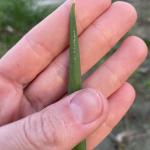 Allium leafminer: We expect to see adult ALM flies emerging in mid-April. The forecasting model predicts emergence to start at 350 GDDs base 1°C starting January 1. Most of MA is currently around 150 GDDs base 1°C, with southeastern MA closer to 180 and the Berkshires closer to 115. MA growers should start scouting allium crops (overwintered onions, perennial chives, early scallions and onions, emerging garlic) for the characteristic lines of oviposition marks, starting the 1st week of April. ALM adults will be emerging from fields that were infested last fall, most likely where leeks were planted. Plan to cover early allium plantings with row cover or insect netting in April, or plan to scout alliums beginning in April and spray no later than 2 weeks after finding oviposition marks. Effective control can be achieved with applications of dinotefuran (e.g. Scorpion, Venom), cyantraniliprole (e.g. Exirel), and spinetoram (e.g. Radiant). Include a surfactant to prevent material runoff. Organic growers can use Entrust (6 oz/A) + M-Pede (1-1.5% v/v solution), applied 2 times, 2-4 weeks after detection. For more information, see our allium leafminer fact sheet.
Allium leafminer: We expect to see adult ALM flies emerging in mid-April. The forecasting model predicts emergence to start at 350 GDDs base 1°C starting January 1. Most of MA is currently around 150 GDDs base 1°C, with southeastern MA closer to 180 and the Berkshires closer to 115. MA growers should start scouting allium crops (overwintered onions, perennial chives, early scallions and onions, emerging garlic) for the characteristic lines of oviposition marks, starting the 1st week of April. ALM adults will be emerging from fields that were infested last fall, most likely where leeks were planted. Plan to cover early allium plantings with row cover or insect netting in April, or plan to scout alliums beginning in April and spray no later than 2 weeks after finding oviposition marks. Effective control can be achieved with applications of dinotefuran (e.g. Scorpion, Venom), cyantraniliprole (e.g. Exirel), and spinetoram (e.g. Radiant). Include a surfactant to prevent material runoff. Organic growers can use Entrust (6 oz/A) + M-Pede (1-1.5% v/v solution), applied 2 times, 2-4 weeks after detection. For more information, see our allium leafminer fact sheet.
Contact Us
Contact the UMass Extension Vegetable Program with your farm-related questions, any time of the year. We always do our best to respond to all inquiries.
Vegetable Program: 413-577-3976, umassveg@umass.edu
Staff Directory: https://ag.umass.edu/vegetable/faculty-staff
Home Gardeners: Please contact the UMass GreenInfo Help Line with home gardening and homesteading questions, at greeninfo@umext.umass.edu.
Managing Fungus Gnats and Shore Flies
Fungus gnat and shore fly adults are a common nuisance in greenhouses, often resulting from overly damp soils with high organic matter. Additionally, fungus gnat larvae feed on plant roots, sometimes causing damage to seedlings directly when populations are very high, or by allowing for pathogens to attack weakened roots. Cultural, biological, and chemical options exist for prevention and management of these pests.
Identification
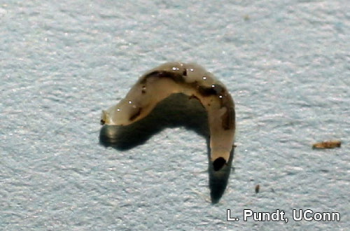
 Fungus gnat adults (Bradysia spp.) are mosquito-like in body shape, about 1/8 inch long, with long legs, a clear pair of wings, and long antennae. They are weak fliers and are frequently observed resting on the media in the pot or running over the foliage or other surfaces. We see them often in spring when gray, cool conditions lead to wet soil as plants are just starting to get going. Their larvae are white and legless, about 1/4-inch long when mature, and have a shiny black head (Figure 1).
Fungus gnat adults (Bradysia spp.) are mosquito-like in body shape, about 1/8 inch long, with long legs, a clear pair of wings, and long antennae. They are weak fliers and are frequently observed resting on the media in the pot or running over the foliage or other surfaces. We see them often in spring when gray, cool conditions lead to wet soil as plants are just starting to get going. Their larvae are white and legless, about 1/4-inch long when mature, and have a shiny black head (Figure 1).
The adult fungus gnat is sometimes confused with another small, dark-bodied fly called the shore fly (Scatella stagnalis). Shore flies have more robust bodies than fungus gnats and their antennae are very short. Their most distinguishing characteristic is the presence of five light-colored spots on each of their dark wings. Shore flies are also stronger, faster fliers than fungus gnats. In the larval stage, shore flies can be distinguished by the opaque, tannish-brown color of the body and the absence of a head capsule. Larvae also have a breathing tube with two dark colored openings called spiracles at the posterior end.
Damage
Fungus gnats and shore flies are attracted to damp locations where fungi, a major part of their diet, are apt to flourish. Studies have shown that fungus gnats develop more rapidly and have greater survival on fungal diets. However, in the absence of a fungal food source, fungus gnats can also feed on healthy plant tissue. While adults are primarily a nuisance, larvae feed on plant roots in addition to fungi and decaying organic matter, sometimes tunneling into the crown and stems of plants. This feeding damage creates wounds that allow soilborne pathogens to enter and potentially kill plants. Fungus gnat larvae may also carry some soil-borne pathogens such as Pythium, Thielaviopsis, and Fusarium. Fungus gnats are generalist feeders and can injure a number of greenhouse flower crops as well as vegetable transplants.
Unlike fungus gnats, shore flies are not known to feed on healthy plant tissue in any life stage and are primarily a nuisance. Adult and larval stages of shore flies feed on algae or decaying organic matter and breed in moist environments.
Life Cycle
Fungus Gnats
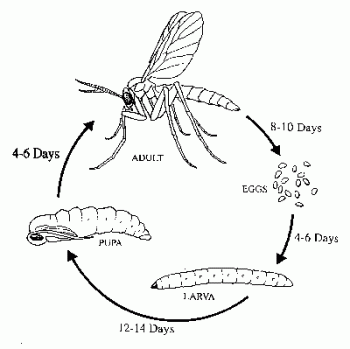 The life cycle of fungus gnats is shown in Figure 2. A female fungus gnat may lay up to 300 whitish eggs in clusters of 20 to 30 or more on the surface or in the crevices of moist soil or potting media rich in organic matter. Eggs hatch in about 6 days. Larvae feed for 12-14 days before becoming pupae, which develop inside a silken pupal chamber in the soil. The pupal stage may last 5-6 days, after which adults emerge and live for up to 10 days. The life cycle from egg to adult requires approximately 4 weeks depending on temperature. Development occurs more rapidly with higher temperatures, as is true of most insects.
The life cycle of fungus gnats is shown in Figure 2. A female fungus gnat may lay up to 300 whitish eggs in clusters of 20 to 30 or more on the surface or in the crevices of moist soil or potting media rich in organic matter. Eggs hatch in about 6 days. Larvae feed for 12-14 days before becoming pupae, which develop inside a silken pupal chamber in the soil. The pupal stage may last 5-6 days, after which adults emerge and live for up to 10 days. The life cycle from egg to adult requires approximately 4 weeks depending on temperature. Development occurs more rapidly with higher temperatures, as is true of most insects.
Shore Flies
Eggs are laid singly on the surface of algae. Pupation occurs at the edge of the algae mats. Breeding takes place in stagnant and strongly saline water found in greenhouses as a result of excessive irrigation and soil leaching. To reduce shore fly numbers, eliminate algae, avoid overwatering, and limit fertilizer run-off.
Detection and Monitoring
As with any pest, fungus gnat and shore fly control programs are built on prevention and monitoring. To prevent infestations, establish a weekly scouting/monitoring routine for the duration of the crop.
To monitor for larvae, place raw potato chunks with peel removed on the soil surface. Larvae are attracted to the potato chunks, under which they move and congregate. Check the potato chunks daily for larvae. Potato disks that are cut 1 inch in diameter and 1/2 to 1 inch thick work well. Ten potato disks may be sufficient to monitor a 10,000 sq. ft greenhouse. Check disks after 48 hours, counting the number of larvae on each disk and any that are present on the growing medium surface. In addition, choose plants on each bench and inspect the soil surface and the area around the base of the plant including the stem just below the soil line. Record the location and the level of infestation. Badly infested containers of plants should be removed as they serve as a source of infestation.
Adult flies can be monitored with yellow sticky cards placed at the base of the plant at soil line. Weekly inspections of yellow sticky cards can detect the onset of an infestation, and continued recording of the number of adults per card per week can aid in evaluating the efficacy of control efforts.
Space 3” x 5” yellow sticky cards at 1-4 per 1,000 sq. ft. throughout the greenhouse. Place yellow cards in a horizontal position just above the soil surface or lay them on the top of the pots. For early detection, position cards near doorways and vents or among new plants being placed in the house. If time permits, check the cards twice weekly, particularly when temperatures warm up in the spring. Research conducted at Cornell University showed that red sticky traps captured more fungus gnat adults than yellow sticky traps. However, yellow sticky traps are commercially available and can be used for a variety of pests in the greenhouse.
Once fungus gnats and/or shore flies begin appearing on sticky cards (Figure 3) or larvae are seen under potato chunks, then it is time to make treatment decisions.
Management
Cultural management strategies are a vital first line of defense for prevention and management of fungus gnats and shore flies. Insect growth regulators, microbials, and other pest control materials applied to the growing medium may be effective in controlling fungus gnat larvae. Most pest control materials do not affect eggs or pupae so repeat applications may be needed.
Cultural management strategies
- Fungus gnat and shore fly populations may be partially suppressed by sanitation practices that eliminate potential breeding areas.
- Keep areas below benches free of spilled potting mix, weeds, and other debris in which fungus gnats and shore flies might breed.
- Potting media should be pasteurized before use if possible.
- Moist potting soil high in organic matter that has been left outdoors for long periods may contain fungus gnat larvae. Fungus gnats and shore flies may also be introduced into the greenhouse in the media of infested plants purchased from other greenhouses. Thoroughly inspect all incoming plant material and make early treatments.
- Eliminate standing pools of water on solid benches, on walks, and under benches. This may be accomplished by proper grading and drainage in the greenhouse and by improving watering practices to prevent runoff.
- Eliminate algae as best you can. Several algicides are currently registered for algae control in the greenhouse. Disinfectants can be used as part of pre-crop cleanup program and during the cropping cycle for routine algae management. For information on disinfectants, see Cleaning & Sanitizing the Greenhouse in the October 20, 2022 issue of Veg Notes.
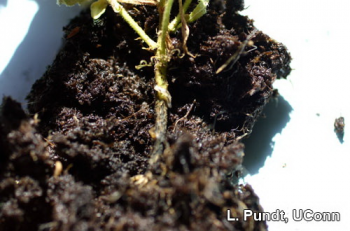 It should be noted that fungus gnat problems are most serious in potting mixes amended with unfinished composts. Microbial activity is excessively high in such mixes, and fungus gnats thrive.
It should be noted that fungus gnat problems are most serious in potting mixes amended with unfinished composts. Microbial activity is excessively high in such mixes, and fungus gnats thrive.
It has also been reported that a pulse in adult emergence follows watering of pots that were previously allowed to dry down. This expected peak in adult fungus gnat populations can be used to time sprays targeting adults or subsequent drenches aimed at larvae.
Prevention and early detection are the keys to controlling this insect, and thus reducing the introduction and spread of disease in the greenhouse.
Biological Control
Several biological control organisms are available for control of fungus gnats including a predaceous mite (Hypoaspis miles), a parasitic nematode (Steinernema feltiae), and a rove beetle (Atheta or Dalotia coriaria).
Bacillus thuringiensis israelensis (bacterium): This soil-borne bacterium may be used before fungus gnat larval populations are high since the bacterium must be ingested to be effective. Applications are more effective on the young larvae (1st instar) than mature (3rd and 4th instars). Bacillus thuringiensis israelensis should be applied until fungus gnat populations start to decline. It is not effective against shore fly larvae. Apply as a drench or in irrigation system according to label directions. It is reported to be toxic to larvae for only 48 hours, so treatments must be repeated. Product name is Gnatrol.
Hypoaspis miles (predatory mite): This predatory mite prefers to feed on young fungus gnat larvae and will also feed on thrips pupae. It may also feed on debris and algae. It is important to make releases early in the growing season before fungus gnat larval populations are abundant. Applications can also be directed to the soil beneath greenhouse benches. Avoid applications into the growing media prior to planting because this decreases survival. Applications need to be initiated after planting and the growing medium should be moist but not saturated. Hypoaspis miles is active when growing medium temperatures are greater than 50°F.
Steinernema feltiae (parasitic nematode): These beneficial nematodes attacks fungus gnat larvae. Nematodes are applied as a drench to containers or flats. They can also be applied through drip irrigation systems, but filters must be removed. Apply nematodes two to three days after inserting cuttings, planting plugs, or starting seeds. To assess the viability of shipments prior to application, place a small quantity of the product in a shallow container with a few drops of tepid water. After a few minutes, look for active nematodes which have a slight ‘J’ curve at the ends of their bodies.
Repeat applications are usually needed. Growing medium temperatures must be 50-80°F, with optimum temperatures of 60-70°F. Irrigate the growing medium before and after applying nematodes. Nematodes are aquatic organisms and require moisture to move throughout the pores of the growing medium. Nematodes should be applied in the evening or on cloudy days as they are extremely sensitive to ultraviolet light desiccation. In general, beneficial nematodes are compatible with most pest control materials except for carbamate and organophosphate pesticides.
Dalotia coriaria, formerly known as Atheta coriaria (rove beetle): This rove beetle is a generalist predator that feeds on fungus gnat and shore fly larvae and reportedly thrips pupae in the growing medium. Adults are slender, dark brown to black, and covered with hairs. The adults are 1/8 inch long with very short wing covers. They fly throughout the greenhouse from original release sites. Larvae are cream to brown in color, depending on age. Both stages inhabit cracks and crevices in the growing medium. Once established in a greenhouse, rove beetles may be present year-round, although populations may fluctuate depending on fungus gnat populations. Because they are generalist feeders, they may consume many other natural enemies including H. miles. In addition, young rove beetle larvae may be fed upon by soil-dwelling predatory mites. However, rove beetles are compatible with beneficial nematodes. These beetles are commercially available as adults from most biological control suppliers. Optimum temperatures are 65-80°F and relative humidity of 50-85%. Both adults and larvae are difficult to detect by scouting since they tend to hide in the cracks and crevices of growing medium.
D. coriaria actively search for prey, primarily targeting eggs, young larvae, and pupae. Because they can fly, adults can travel through a greenhouse, aiding distribution and population development.
Coenosia attenuata (hunter flies): Hunter flies are small flies which closely resemble common house flies. Adult hunter flies attack and feed on flying prey including fungus gnat, shore fly, whitefly, and leafminer adults. They are introduced either on new plant material or by flying into unsprayed greenhouses during the growing season. Yellow sticky cards may trap hunter fly adults. The soil-dwelling larvae are also predaceous and feed on fungus gnat larvae and other insects in the growing medium.
Synacra pauperi (parasitoid wasp): Females of this species insert eggs into fungus gnat larvae, which then hatch and feed on the fungus gnat larvae. Parasitized fungus gnat larvae live until pupation, after which an adult Synacra paupera emerges. This parasitic wasp may also be captured on sticky cards, especially in unsprayed greenhouses, and may resemble a fungus gnat at first glance. However, these wasps have a notable constriction between their thorax and abdomen and long beaded, elbowed antennae. Their maximum rate of increase is higher than fungus gnat larvae at 73°F.
Most biological control options used for fungus gnat control do not appear to work as well against shore flies because of the semi-aquatic environment in which they live. Beneficial nematodes (S. carpocapsae) will infect shore fly larvae but may not offer sufficient levels of control in commercial greenhouses. In unsprayed greenhouses, a tiny parasitoid of shore flies, Hexacola neoscatellae, occurs naturally in greenhouse and may slow the growth rate of shore fly populations. The rove beetle Dalotia coriaria may be an option for biological control of shore flies, but will not work on larvae that are in standing water.
Pesticide Treatments
If insecticides are used for treatment, soil treatments directed toward the larval stage at the first sign of insect activity are best to manage fungus gnats. Make sure material is applied to a depth of 1” or more. Materials are most effective when they are retained in the media. Keep this in mind when fertilizers, fungicides, and water all need to be applied to plants. For example, if a fungicide and an insecticide is necessary, apply the fungicide first, then water it in with the insecticide. The fungicide will be moved into the root zone where it is needed and the insecticide will stay in the top where it is needed. Some insecticides are labeled for use on greenhouse floors and under benches in addition to treatments to pots. Insecticides may not affect eggs or pupae, and repeated applications may be necessary. Carefully read and follow all label directions.
For a list of pesticides and more information on using biological control to manage fungus gnats see the current issue of the New England Vegetable Management Guide.
Further Reading
- The University of California’s fact sheet on Fungus Gnats, Shore Flies, etc.
- Using Beneficial Nematodes to Manage Pests in Greenhouses (video)
-- Written by Tina Smith, UMass Extension Greenhouse Crops and Floriculture Program Emeritus. Revised by Alireza Shokoohi, 2024.
Calculating Fertilizer Applications
It can feel overwhelming to calculate fertilizer needs for each of the many crops and fields on your farm. Every year we help growers, both new and seasoned, to make these calculations. If you follow these steps, the process should get easier over time. Our recommendation is always to make these calculations to determine what you should add in an “ideal” setting (if fertilizer was free and easily available and you had all the time in the world), and then figure out what you can realistically add to your fields, based on what is available and economical. Keep records on what you apply so that you can make educated changes to your applications if you see nutrient deficiencies in your crops. Here are the steps to follow, with details below:
-
Work from a soil test.
-
Find nutrient recommendations for your crop.
-
Calculate nitrogen credits.
-
Contributions from previous applications of organic amendments, like compost and manure
-
Cover crop nitrogen contributions
-
Soil organic matter contributions
-
Contributions from sod plowdown
-
Choose your fertilizer.
-
Calculate fertilizer needed to meet N needs.
-
Calculate how much P and K that fertilizer will add.
-
Calculate how much additional fertilizer you need to reach your other nutrient needs.
 Work from a soil test. A typical standard soil test will report macro- and micronutrient levels and soil pH. Some labs will automatically report soil organic matter (SOM) levels, and at other labs (including the UMass Soil Lab) you need to specifically request for SOM to be tested. UMass Soil Lab reports provide the soil nutrient level and optimum range of each nutrient in parts per million. Macronutrient (phosphorous, potassium, calcium, and magnesium) levels are also reported as very low, low, optimum, or above optimum. Because nitrogen is so mobile and ephemeral in soils, nitrogen is not routinely tested for in soil tests, and instead, nitrogen applications are made solely based on crop need. To test plant available nitrate during the growing season, you can take a pre-sidedress nitrate test. We highly recommend having your soil tested at one of the New England state soil labs, as the tests run at these labs are specific to New England soils.
Work from a soil test. A typical standard soil test will report macro- and micronutrient levels and soil pH. Some labs will automatically report soil organic matter (SOM) levels, and at other labs (including the UMass Soil Lab) you need to specifically request for SOM to be tested. UMass Soil Lab reports provide the soil nutrient level and optimum range of each nutrient in parts per million. Macronutrient (phosphorous, potassium, calcium, and magnesium) levels are also reported as very low, low, optimum, or above optimum. Because nitrogen is so mobile and ephemeral in soils, nitrogen is not routinely tested for in soil tests, and instead, nitrogen applications are made solely based on crop need. To test plant available nitrate during the growing season, you can take a pre-sidedress nitrate test. We highly recommend having your soil tested at one of the New England state soil labs, as the tests run at these labs are specific to New England soils.
Note for high tunnels: If you are calculating fertilizer applications for a high tunnel, we recommend taking both a standard soil test and a saturated media extract test. The standard test procedure extracts reserve nutrients and reports the nutrient levels that will become available to plants as the season progresses. In the warm, well-watered high tunnel environment, crops will immediately grow very quickly, so it’s also important to know what nutrients are immediately available to those plants. This is measured using a saturated media extract (SME) test. For long-term high tunnel crops like tomatoes, cucumbers, or peppers, use both the standard soil test and the SME to plan nutrient applications in the spring, and then take leaf tissue samples monthly to inform fertigation or side-dressing during the season (more information on tissue testing here). The UMaine Soil Lab offers a Long-Term/Combined High Tunnel Package that includes both a standard and SME test and corresponding recommendations.
-
Find nutrient recommendations for your c
 rop. If you indicated a crop on your soil test submission, you will receive nutrient application recommendations based on the crop need and the soil test results. For commercial vegetable growers, those recommendations will be in lbs/acre; for home gardeners, they will be lbs/100 sq. ft. If you don’t indicate a crop on your soil test form, you can easily look up crop-specific recommendations in the crop sections of the New England Vegetable Management Guide. In this example, we’ll make a fertilizer plan for broccoli, so the nutrient recommendations will be from the Cabbage, Broccoli, Cauliflower, and other Brassica Crops section.
rop. If you indicated a crop on your soil test submission, you will receive nutrient application recommendations based on the crop need and the soil test results. For commercial vegetable growers, those recommendations will be in lbs/acre; for home gardeners, they will be lbs/100 sq. ft. If you don’t indicate a crop on your soil test form, you can easily look up crop-specific recommendations in the crop sections of the New England Vegetable Management Guide. In this example, we’ll make a fertilizer plan for broccoli, so the nutrient recommendations will be from the Cabbage, Broccoli, Cauliflower, and other Brassica Crops section.
For most crops, these tables are split between up-front application (broadcast and incorporate) and sidedressing a certain number of weeks after seeding or transplanting. All of the P and K that a crop needs can be put down up front, before planting, because P and K will stay in the soil and remain available for when the crop needs them. Depending on the N source, N applications can be applied 100% pre-plant or split between pre-plant and sidedressing. Inorganic forms of N (e.g. urea) will leach quickly from soil, so any N you put down pre-plant that your crop doesn’t take up relatively quickly will leach out, along with the money you spent on it! Organic forms of N are released slowly by microbial activity throughout the season, so if you are using an organic form of N, you can apply all N up front, along with P and K.
Broccoli N recommendations are 100 lbs/A pre-plant and 60 lbs/A four weeks after transplant (circled in yellow). We’ll do our calculations using Kreher’s 5-4-3 chicken manure, which is an organic amendment that will release N slowly, so we will apply the full 160 lbs/A up front.
P and K recommendations are based on your soil test recommendations. In our example soil test, our P levels are optimum, so the recommendation is to add 50 lbs P/A (circled in red). New England state soil tests are based on a “build and maintain” model, which recommends you add nutrients even when the level in the soil is optimum, so that soil reserves are not depleted. In our example, K levels are low, so we should add 125 lbs K/A (circled in blue).
-
Calculate nitrogen credits. Manure, compost, some cover crops, soil organic matter, and sod all contain N that can be credited towards your total N needs for the season. The recommendation entered at the top of Table 1 is the preplant nutrient recommendation from step 2, and the following paragraphs will explain how the credits are calculated:
Table 1. Nutrient credit calculations
Recommendations
(from step 2)
N
160 lbs/A
P
50 lbs/A
K
125 lbs/A
Credits
Manure
-
-
- Compost
-
-
- Cover crop
10
-
- Soil organic matter
40
-
- Sod
-
-
- Total credits
50
0
0 Nutrients needed 110 50 125
Manure and compost: Like soil, manures and composts can be analyzed by a soil testing lab to determine the nutrient content, pH, C:N ratio, and other important characteristics. Compost and manure analysis is available through the Penn State and UMaine soil testing labs. If testing your organic amendment is not possible, approximations can be found in Table 2.
Cover crops: When a cover crop is tilled in, N stored in the leaves and roots is released and much of it will be available for your summer and fall crops. The maximum amount of N is released 4-6 weeks after incorporation. In the spring, the soil doesn’t warm up fast enough for the microbes to release the N before the main crop needs it, so don’t include N credits from cover crops for early spring crops. Sod also contributes some N when it’s plowed under to start production in a new field. Table 3 shows estimates of N contributions from certain cover crops. These numbers can vary widely, based on the quality of the cover crop stand and time of incorporation. If you’re interested in learning more, the SARE publication Managing Cover Crops Profitably is a great resource.
Soil organic matter: Soil organic matter (SOM) contains N that becomes available for plant uptake slowly throughout the season as it is released through microbial activity. The general rule of thumb in MA is: credit yourself 10-20 lbs/A of plant-available N per 1% SOM, capped at 4% or 40 lbs/A. The amount of N released from SOM increases with soil temperature, so numbers may vary between New England states.
Our example soil test results show SOM content of 4.4%, and we’ll say that we incorporated a buckwheat cover crop. The following credits are entered into Table 1:
- Buckwheat cover crop: 10 lbs N/A
- Soil organic matter: Our example field has 4.4% SOM. 4.4 x 20 lbs/A = 88 lbs N/A, but SOM credits max out at 40 lbs/A, so we'll credit ourselves 40 lbs/A.
After subtracting our nitrogen credits from our total nitrogen needs, we now need to apply only 110 lbs N/A.
-
Choose your fertilizer. This choice can be made based on many different factors, including:
-
What fertilizer you already have on hand
- Price
- Application equipment (some materials are easier to spread with certain types of spreaders)
- Availability of materials from local distributers
- What materials meet your nutrient needs most closely
We’ll use Kreher’s 5-4-3 chicken manure for this example. “5-4-3” means that the material contains 5% N, 4% P, and 3% K.
-
Calculate how much fertilizer you need to apply to meet your pre-plant N needs.
We need to apply 110 lbs/A N (from Table 1) and our fertilizer is 5% N: 110 lbs/A nitrogen ÷ 0.05 = 2,200 lbs/A 5-4-3
In order to apply 110 lbs/A of N, we need to apply 2,200 lbs/A of 5-4-3.
-
Calculate how much P and K that amount of fertilizer will add.
Kreher’s 5-4-3 is 4% P and 3% K.
- 2,200 lbs/A of 5-4-3 x 0.04 = 88 lbs/A P
Total P needed (from Table 1) = 50 lbs/A. Our application of 5-4-3 will apply 88 lbs/A of P, so we are actually overapplying P and do not need to apply any more.*
- 2,200 lbs/A of 5-4-3 x 0.03 = 66 lbs/A K
Total K needed (from Table 1) = 125 lbs/A.
125 lbs/A – 66 lbs/A = 59 lbs/A K
Our application of 5-4-3 will apply 66 lbs/A of K, so we need to put down an additional 59 lbs/A to reach our total K need.
-
Calculate how much additional fertilizer you need to reach your other nutrient needs.
We need to apply an additional 59 lbs/A of K. We’ll use potash (0-0-50) to meet that need.
59 lbs/A K ÷ 0.5 = 118 lbs/A potash.
In order to apply 59 lbs/A of K, we need to apply 118 lbs/A of potash.
Now we have ideal application rates for both of our fertilizers:
- 2,200 lbs/A Krehers 5-4-3
- 118 lbs/A potash
And you’re ready to brew a big pot of coffee and do the same math for your remaining fields and crops!
*It is easy to overapply P with a blended fertilizer like this, that is relatively high in P compared to N. Overapplying P by large amounts and over long periods of time can lead to phosphorous runoff and leaching and environmental contamination. We used 5-4-3 for this example because it's commonly used, but to more accurately meet the crop nutrient needs and avoid overapplying P, organic growers can instead apply feather meal (13-0-0), bone char (0-15-0, and potash (0-0-50).
--Written by G. Higgins with many thanks to Becky Maden of UVM Extension
Improve Pest Management by Planning Ahead
Integrated Pest Management (IPM) is a stepwise approach to managing pests that combines accurate knowledge of the pest and level of potential harm with multiple tactics to prevent, reduce, or eliminate the effect of pests (disease, insects, weeds, or even abiotic issues) on your crops. It is not an alternative to organic or conventional production, but is a strategy that can be used by any grower, whether using OMRI-listed or conventional materials.
Over decades of working directly with growers to implement IPM on their farms, we have developed an IPM planning template to help you focus and be successful with your pest management strategies. Following are instructions for completing an IPM Plan (click on the link for a blank template).
We have been working with NRCS to develop a framework for providing farms with funding to implement IPM plans. If you have an NRCS planner, ask them about adding pest management to your conservation plan!
Crop & Pest columns: Choose up to 5 pest-crop combinations you would like to work on most this season. We have found that choosing no more than 5 pest issues each season leads to more successful pest management because it allows you to focus on learning pest identification and life cycles and become more confident at using control strategies that work. Often, growers will choose to focus on their most valuable or newest crop(s). Each season, you can choose new pests and crops to build on your IPM knowledge from the previous year.
Past Control Strategies column: Write down what strategies you have tried before. What worked? What didn’t work? Take a moment to think about your crop quality, inputs, and yields this season in terms of the pest in question. Did you implement a practice that reduced pesticide use, labor, or other inputs on the crop? Was the crop more profitable? Perhaps some of your strategies worked, but not others; write down both. “I don’t know” may be what you write down, especially if you are working with a crop or pest that you don’t have much experience with.
Future IPM Strategies column: List the strategies that you plan to use. Be picky; only write down the strategies you think you will actually use. Below are core IPM strategies to choose from.
Accurate identification: Determine the true underlying cause of the pest problem through soil or plant tissue testing, disease diagnostics, insect and weed identification, or other methods. Often, pest identification is the most important task in the first year of developing an IPM plan.
Pest scouting: Determine pest levels, damage, and life stages, and keep records over time. We recommend weekly scouting for most crops (sometimes more frequently, for example as pest levels approach thresholds). See our scouting resources page for pest scouting sheets that we have developed for different crops.
Monitoring & Forecasting: Use data loggers, pheromone traps, online networks, pest models, and pest or weather forecasts to monitor or predict pest arrival/emergence and potential for damage.
Cultural practices: E.g., crop rotation, mulches, irrigation, resistant varieties, row covers.
Biological control: Attract and/or release beneficial insects, predators, or parasitoids to control pests.
Chemical control: Choose the right materials and spray timing. Improve coverage and manage for resistance.
This Year’s Plan column: Fill in the year here. Get more specific with the strategies you listed in the previous column. Use our Scouting Toolkit Inventory to find out what supplies you will need for the season and where to buy them. Write down the tools and supplies needed, people involved, resources to use, etc. Write down the steps necessary to implement your plan and who will do them.
Calendar Alert column: When does each task need to be completed or planned? Jot down dates or set calendar reminders to make sure you set up traps on time, know when to begin scouting for a pest, etc. See our Pest Scouting Calendar to get an idea when pests first appear, or rely on your past experience to plan.
Notes column: Consider other factors that may impact your pest management success but may not be directly related to your plan. For example: equipment or labor shortages, unpredictable weather, underlying field conditions (e.g., rocky, low fertility, prior crops, surrounding environment), etc. Write down any of these outside influences that may have a specific effect on your plan.
Here is a sample IPM plan from a grower we have worked with in the past to guide you. In this example, we select one pest to tackle using the IPM principles of accurate pest identification, scouting, monitoring, and implementing an effective chemical control at the right time.
| Crop(s) | pest | past control strategies | future ipm strategies | this year's plan | calendar alert | notes |
|---|---|---|---|---|---|---|
|
Summer squash, zucchini, winter squash |
Squash vine borer |
We identify the larvae in stalks but it's too late to treat once they are infesting the crop. 30% yield loss from fruit infestation in fall. We didn't know there could be 2 generations per year!
What didn't work? Treatment was too late since Entrust must be consumed by the larvae before they enter the stalk. Row cover is not practical on a large scale. We need to know when adults arrive, how to ID eggs, and when to treat so that we can target larvae before they enter the plant.
|
Accurate ID: adults and eggs
Monitoring: Use pheromone trap to determine arrival of adults. Trap is to be placed in the top of the crop canopy about 3 ft above the ground.
Chemical control: Use Entrust, targeting bases of plants at threshold of 5 adults/trap in non-vining crops and 12 adults/trap in vining crops. |
Get Pest ID Guide from UMass Extension.
Manager orders trap and pheromones from Great Lakes IPM.
Manager will set up trap with field crew and assign a scout. Place trap in field where winter squash was last year, then move to summer squash field when adults are first trapped.
Scout will check traps weekly and scout for eggs then report to manager.
Farmer will treat at threshold. |
December 3: Order trapping supplies and ID Guide
May 15: Set up trap
Early June: scout for eggs near bases of plants.
Weekly, May 15-harvest: Check trap and scout field. Spray if threshold is reached. |
High pressure expected because summer squash is being grown in the field adjacent to last year's winter squash, which had a high level of infestation and was not tilled in to destroy pupae because field is no-till. |
--UMass Vegetable Program
News
UMass Extension Weed Survey
UMass Extension's new weeds specialist, Maria Gannett, would like to know what she should focus on. Fill out this survey to let her know which weeds you struggle with the most, which weed management techniques you want to know more about, or just use it to complain about weeds! Thanks for sharing your thoughts with us.
Click here to take the brief survey!
MDAR Grant Programs for Farmers Now Open
MDAR Viability Grants: 3 Programs
Farm Viability Enhancement Program (FVEP)
For established farms that own and operate on unrestricted farmland: Provides business planning and technical assistance to develop or update a business plan for established commercial farms that own and operate unrestricted farmland. In return for a short-term covenant to keep the land in agricultural use, operators may be eligible for grants to implement capital projects on the farm that have been identified in the business plan completed through the program. Up to $200,000 depending on size of farm and acreage protected.
Applications Due: 4:00 PM on Thursday, April 18, 2024
Contact: Laura Barley at Laura.Barley@mass.gov or (857) 507-5548.
APR Improvement Program (AIP)
For APR farms. Provides business planning and technical assistance and potentially offers grants to fund capital improvements to farm infrastructure. Up to $150,000 depending on size of farm and acreage under APR, available on cost reimbursement basis, with required 10% match contribution.
Applications Due: 4:00 PM on Thursday, April 18, 2024
Contact: Melissa Adams at Melissa.L.Adams@mass.gov or (413) 726-2001
Matching Enterprise Grants Program (MEGA)
For beginning farmers: Provides business planning and technical assistance, and grant funds may be available on a one-to-one matching cash reimbursement basis for equipment, infrastructure, or other capital improvements. Up to $30,000 depending on number of years the farm has been in business, minimum gross income, and previous receipt of a MEGA award. Prior MEGA recipients may be eligible to apply for a second award.
Applications Due: 4:00 PM on Thursday, April 18, 2024
Contact: Jess Camp at Jessica.Camp@mass.gov or (617) 823-0871
Urban Agriculture Program
This program award grants statewide to promote strategies addressing food insecurity, to expand and create new economic opportunities and to increase access to fresh, local produce in urban neighborhoods. $5,000-$50,000 for commercial urban agriculture projects, $1,000-$20,000 for community garden and food production projects, or $150,000 for land acquisition (restrictions apply).
Applications Due: 4:00 PM on Monday, May 6, 2024
Contact: Rose Arruda at Rose.Arrruda@mass.gov or (617) 851-3644
Food Security Infrastructure Grant (FSIG)
The FSIG Program seeks to ensure that farmers, commercial fishermen, and other local food producers are better engaged with a strong, resilient food system to help mitigate food supply and distribution disruptions, as well as to ensure that individuals and families throughout the Commonwealth have equitable access to food, with a focus on food that is produced locally. Up to $500,000, on a reimbursement basis.
Applications Due: 4:00 PM on Thursday, May 2, 2024
Contact: Laura Maul at Laura.Maul@mass.gov or (857) 507-5972
Resilient Food Systems Infrastructure Grant (RFSI)
To fund projects that expand capacity, aggregation, processing, manufacturing, storing, transporting, wholesaling, and distribution of locally and regionally produced food products, including specialty crops, dairy, grains for human consumption, aquaculture, and other food products, excluding meat and poultry. MDAR plans to award grants to support infrastructure in the middle-of-the-supply-chain for domestic food and farm businesses and other eligible entities.
MDAR will accept one of two types of proposals from applicants for this grant funding:
Infrastructure Grants - large-scale grants up to $500,000 that will enhance resilience in the middle-of-the-supply-chain and strengthen local and regional food systems by creating new revenue streams for producers, and
Simplified Equipment-Only Grants - equipment-only fixed-price grants between $10,000 and $100,000.
Applications Due: 4:00pm on Friday, March 29, 2024
Stewardship Assistance and Restoration on APRs (SARA)
For APR Owners: The goal of SARA is to restore the overall utilization of APR land resources for commercial agriculture. Grant funds of up to $35,000 are available on a cost reimbursement basis with a 15% match of total project costs required by the farm participant. Funds must be used for projects to restore inactive farmland back into active commercial agricultural use or to restore resources for increased agricultural production on existing APR farmland. Responder must not have been the original owner of the property when the land was placed under the APR unless the proposed restoration is in response to damage caused by a natural disaster or third party. Leasing farmers eligible.
Applications Due: 2:00 PM on Thursday, April 18, 2024
Contact: Julie Weiss at Julie.Weiss@mass.gov or (617) 913-5317
Coming Soon:
Climate Smart Agriculture Program
Agricultural Food Safety Improvement Program
New Massachusetts Agriculture Youth Council
MDAR is proud to announce the creation of the Massachusetts Agriculture Youth Council. This Council is created to cultivate and foster the next generation of leaders in the agriculture industry. The Council will be comprised of high school students in their senior year and will meet monthly to discuss agricultural issues, hear from guest speakers from the agriculture industry, learn about the legislative procedures and workforce development opportunities, attend special events and tours, and enhance professional skills.
We encourage all current Massachusetts High School juniors to learn more and apply to the council. Click here to learn more, and feel free to share this flyer!
Events
Fundamentals of Organic Production Workshop Series
When: Several dates, 10:00am – 11:30am, or as noted below
Where: online via Zoom, or in-person as noted below
Registration: Free! See each event page, below, to register.
Are you looking to increase or improve your organic growing methods? Join UMass Extension and NOFA/Mass for a series on fundamentals of organic vegetable and small fruit production. This series is part of the USDA Transition to Organic Partnership Program (TOPP). To learn more about the UMass & NOFA/Mass programming, check out the NOFA/Mass TOPP web page. To learn more about the national TOPP program, visit www.organictransition.org.
These workshops are intended for commercial vegetable and small fruit growers. See the links below for information and registration for each workshop.
Recorded Workshops:
Cover Cropping – Part 1 and Part 2
Upcoming Workshops:
March 27: Organic Greenhouse Production – in person! This course is 10am to 1pm, and includes lunch
April 10: Organic Management of Vegetable Pests
April 24: Organics and Food Safety
This series also includes 2 in-person field walks this summer. Save these dates and stay tuned for more details and registration info!
June 25: Brookfield Farm, Amherst, MA
July 9: TBD
There will also be opportunities for one-on-one consultations with UMass Extension specialists in fall 2024. Visit the NOFA/Mass TOPP web page for more ways to get involved!
Save the Date! 1st Annual Massachusetts Agricultural Resource Fair
When: Friday, April 12, 9am-3pm
Where: MA Division of Fisheries and Wildlife Building, 1 Rabbit Hill Road, Westborough, MA 01581
State and federal agencies, as well as agricultural service providers, will be at this event to offer the farming community information on available agricultural resources. More information coming soon!
Vegetable Notes. Genevieve Higgins, Lisa McKeag, Susan Scheufele, Hannah Whitehead co-editors. All photos in this publication are credited to the UMass Extension Vegetable Program unless otherwise noted.
Where trade names or commercial products are used, no company or product endorsement is implied or intended. Always read the label before using any pesticide. The label is the legal document for product use. Disregard any information in this newsletter if it is in conflict with the label.
The University of Massachusetts Extension is an equal opportunity provider and employer, United States Department of Agriculture cooperating. Contact your local Extension office for information on disability accommodations. Contact the State Center Directors Office if you have concerns related to discrimination, 413-545-4800.
